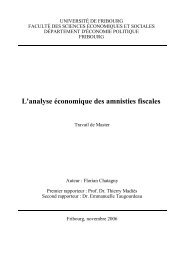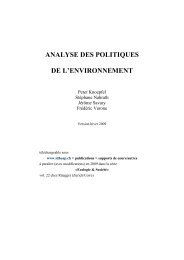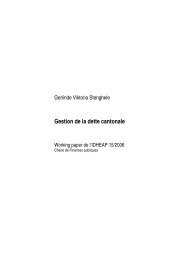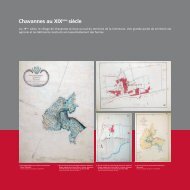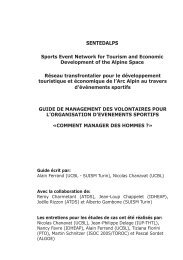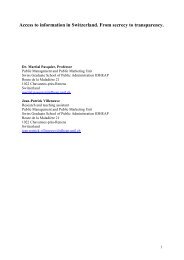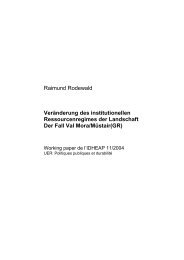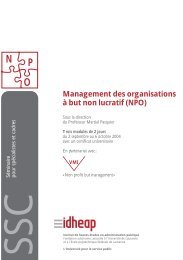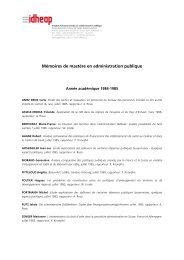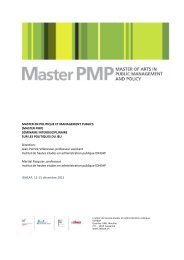Voting advice applications and party choice: evidence from ...
Voting advice applications and party choice: evidence from ...
Voting advice applications and party choice: evidence from ...
Create successful ePaper yourself
Turn your PDF publications into a flip-book with our unique Google optimized e-Paper software.
370 A. Ladner, J. Fivaz <strong>and</strong> J. Pianzola<br />
Klein (2006, p.595) emphasises the importance of issue voting <strong>and</strong> describes,<br />
according to normative democratic theories, the ideal voter as follows: the ideal voter<br />
informs himself carefully about all the pressing political issues <strong>and</strong> the positions of<br />
political parties toward them. Then the voter compares the parties’ positions with his<br />
own preferences <strong>and</strong> makes voting decisions based on this matching. Klein concludes<br />
that the services provided by VAAs come very close to this normative ideal for electoral<br />
decision-making.<br />
All VAAs are based on the concept of issue voting or, to be more precise, on the<br />
well-known proximity model of Downs (1957). Downs’ original model had a simple<br />
setting that was based on an election with only one issue dimension (usually the left-right<br />
dimension) <strong>and</strong> only two competing c<strong>and</strong>idates. According to Downs, a voter will vote<br />
for the c<strong>and</strong>idate that is closest to one’s own position on the particular issue dimension.<br />
Downs’ model fits quite well for elections within the electoral system in the USA. Over<br />
the following years, the model was adapted to more complex electoral systems such as<br />
those in European countries (e.g. constituencies with more than one seat, <strong>party</strong> systems<br />
with more than two parties, or electoral systems with open lists; see Cox,1997). The<br />
model was also extended in the direction of including multiple issue dimensions instead<br />
of only one.<br />
By adapting the model to more complex electoral <strong>and</strong> <strong>party</strong> systems beyond that of<br />
the USA, the model itself increased in complexity. Today, the proximity-voting model is<br />
often criticised on the grounds that the average voter is not willing to or even capable<br />
of gathering <strong>and</strong> processing all the necessary information to perform the dem<strong>and</strong>ed<br />
comparison of policy positions. This might be feasible in the rather simplified original<br />
model, but clearly not in elections with multiple parties debating on a large number of<br />
political issues (Rabinowitz <strong>and</strong> MacDonald, 1989).<br />
This critique concerning voters’ limited information-collecting <strong>and</strong> informationprocessing<br />
capacities opens a link to VAAs because they seem to offer an interesting<br />
solution. VAAs reduce voters’ information <strong>and</strong> transaction costs at large (Jeitziner,<br />
2004). They provide easily accessible information on the policy positions of political<br />
parties <strong>and</strong> not only for one issue but for a large number of issues. Supported by a VAA,<br />
everyone should be capable of conducting his own personalised issue-matching with all<br />
the relevant political parties within a couple of minutes. Given the large number of voters<br />
using VAAs, they are obviously offering services that are needed <strong>and</strong> appreciated by<br />
voters.<br />
This leads us to our assumption that VAAs have an impact on the electoral <strong>choice</strong>s of<br />
the voters using them. This assumption is supported by an observation about voters’<br />
<strong>party</strong> attachment. Party attachment is seen within the social-psychological theory of<br />
voting as one of the main factors to explain voting decisions (e.g. Schoen <strong>and</strong> Weiss,<br />
2005). Voters use a close <strong>party</strong> identification as a kind of a shortcut or cue that allows<br />
them to reduce both the complexity <strong>and</strong> the cost of making a voting decision. However,<br />
the last ten to 20 years have shown a constant decline in voters’ <strong>party</strong> attachments in<br />
almost all advanced democracies. Voters’ ties to parties are loosening (e.g. there has been<br />
a decline in <strong>party</strong> memberships or growth in distrust of parties). Furthermore, their<br />
electoral behaviour has become more volatile <strong>and</strong> led to an increase in swing-voting<br />
(Dalton <strong>and</strong> Wattenberg, 2000; Dalton, 2006). Because of this evident decline, the<br />
explanatory power of <strong>party</strong> attachment for electoral <strong>choice</strong> seems questionable, <strong>and</strong> it<br />
leads to the assumption that voters might be more open to seeking new cues with respect<br />
to their voting decisions.



